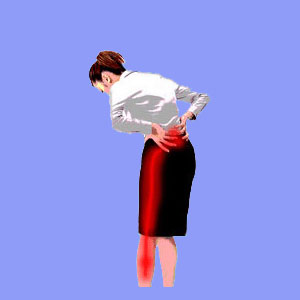
Sciatica from bending is a typical patient complaint that links symptomatic flare-ups to bending forward at the waist. Bending is a normal life activity, but is commonly implicated as an exacerbator of back pain due to various reasons. However, as we have reported previously, there is nothing inherently bad about bending and as long as proper ergonomic practices are maintained, the back should be fully capable of bending from birth to old age.
Sciatica has the distinction of being linked to a very large diversity of aggravating factors, movements and positions, as we detail throughout this website. However, the actual evidence linking pain to many of these exacerbators remains weak, while the psychoemotional link is clear and strong. This fact always comes as a shock for patients who insist that the activity itself is the cause, rather than the belief that the activity is the source of pain.
This interesting article examines how sciatica and bending might be related both anatomically, as well as psychologically. If you suffer worse symptoms after bending to work or perform any physical activity, then this article is perfectly suited for you present research needs.
Anatomical Link Between Sciatica and Bending
True spinal sciatica is caused by compression or irritation of particular nerve roots in the lower back. These nerves, located between L4 and S3, are certainly in the right location to be influenced by the anatomical changes associated with bending, aren’t they? After all, the body bends at the waist and these are close by, no? Well actually, yes and no.
The waist is above the lumbar spinal levels that form the sciatic nerve. In fact, the L4 level is positioned at the top of the pelvic ilium, which is a bit below the waist and not an anatomical point that actually bends forward much. The remainder of the sciatic nerve roots are even lower and 3 of them are contained in the sacrum, which does not bend or flex interiorly at all. So, why does bending worsen sciatica?
Well, prior to these nerves exiting the spinal column at their respective levels, they exist en masse in the central canal. This is where they can certainly be easily influenced by bending at the waist, as well as at the locations where they exit the spine. Bending distorts the central spinal canal and can theoretically aggravate existing stenosis conditions in some instances. However, clinical evidence shows that most central spinal stenosis is relieved by bending forward, which is logical, since this position extends and expands the central canal, often relieving pressure, rather than causing it. Bending can also have a similar effect on foraminal stenosis, although once again, clinical evidence generally shows that bending actually increases the patency of stenotic foramen, making the act of bending seem quite therapeutic and not pathological at all.
Remember, physical therapy employs many bending positions, as does yoga, Pilates and tai chi. All of these practices are considered highly therapeutic and effective for treating a range of dorsalgia and sciatica complaints. So what is the real story?
Psychological Link Between Sciatica and Bending
Bending is thought to be harmful to the back, so it is understandable that patients suffer pain upon bending due to nocebo influence. This is logical and has been witnessed clinically for generations. Of course, this effect is not limited to bending, but can occur due to any position or activity-related aggravators, like sitting, standing or lifting. We see nocebo links to sciatica symptoms often, with the mind being the source process for symptomatic escalation from a variety of beliefs, rather than any actual physical problem.
This is also why patients seem so confused when presented with the anatomical facts of how bending actually influences their spine. In most cases, it seems that bending should be therapeutic, but since it results in pain (and this pain is very, very real), there is a disconnect between scientific fact and the patient’s own reality.
Sciatica from Bending Clinical Experience
So, what have we learned from all these years working with sciatica patients? Well, besides the rather surprising anatomical facts about how bending influences the spine, and the even more shocking occurrence of pain related to nocebo due to belief that bending is bad, rather than the reality that bending is basically a nonissue, there is another very critical idea missing from this clinical presentation of pain.
Bending takes the combined effort of numerous muscles in the back, neck, buttocks and legs. It is often these muscles that are the source of pain, either directly experienced or influencing the sciatic nerve due to piriformis compression or other mechanism of action. We have witnessed many cases of pseudo-sciatica that were caused by muscle imbalances and overly tight hamstrings.
We have only seen a few cases where atypical spinal pathology was truly negatively influenced by bending. We have seen lots and lots of patients with mindbody symptoms who simply believed that bending (as well as many other innocent activities) was bad, and so they suffered when they bent. Our point is that bending might be a villain for the mind more than for the back. Bending may also produce pain due to muscular issues and interactions on a purely physical level. However, the changes in spinal anatomy that would cause true sciatica to escalate from bending are the least often reproduced clinically, hopefully changing peoples’ perception of the cause of sciatica in millions of cases.





